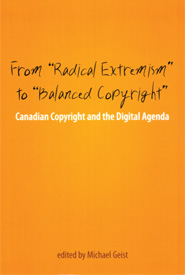From ‘Radical Extremism’to ‘Balanced Copyright’: Canadian Copyright and the Digital Agenda

Michael Geist, ed. Toronto, ON: Irwin Law Inc, 2010; 651 pp; ISBN: 978-1-55221-204-2, paper $65 cdn; ISBN: 978-1-55221-206-6, e-book.
By Jay Rahn
The federal government introduced Bill C-32, the Copyright Modernization Act, in June of this year. Since then, law professor Michael Geist and his students at the University of Ottawa have compiled and edited cogent studies of Bill C-32 by 20 of Canada’s leading academic specialists in copyright law. As of this writing, an all-party, parliamentary committee for the review of C-32 has just been announced.
As university teachers, researchers, and librarians, CAUT members should be concerned about what ends up in Bill C-32. For example, according to its current wording, one would have to destroy research material received via an interlibrary loan within five days. As well, it would be an infringement of copyright to circumvent a digital lock on research material in order to make a back-up copy or merely to view it — even if a publication’s copyright had already expired.
Indeed, insofar as proposals for funded research are subject to ethics review, one’s research might be stalled before it begins, for as the relevant Tri-Council Policy Statement specifies, “ethical approaches cannot preempt the application of the law.”
University and college teachers might assume the bill’s addition of “education” to the list of fair-dealing exceptions provides a carte-blanche privilege to copy copyrighted works willy-nilly. Indeed, propaganda efforts of lobby groups funded by multinational publishers have already spread this misinformation throughout Canada in op-ed pieces in large-circulation newspapers. However, including education in the list of fair-dealing exceptions merely renders certain uses of copyright material eligible for a six-fold test of fair dealing. Established in a landmark Supreme Court decision of 2004 (CCH v LSUC), this test was applied as recently as last July in a ruling which showed that a fair-dealing exception is not, as the corporate lobbyists would have it, a slam-dunk carte-blanche “exemption.”
Notwithstanding the misinformation campaigns of publishers and what some have termed the “copyright-collective industry,” which includes staffers and hired-gun lawyers who propose tariffs at the Copyright Board, whether or not Bill C-32 passes in its present form might well be of little direct consequence to teaching at Canadian universities.
Canadian universities already reimburse publishers and their authors/creators through licences and contracts that make periodicals, books and sound recordings accessible to their faculty and students. Also, copying of much non-licensed and non-contracted material arguably would accord with the existing fair-dealing exceptions for research and private study.
Moreover, increasing amounts of valuable material for teaching and research are becoming accessible at no cost through open-access initiatives, Creative Commons licences and universities’ individual digital repositories. Indeed, as Margaret Ann Wilkinson argues in a must-read chapter on copyright collectives and contracts, “the copyright environment of Canada is being changed by players other than Parliament.”
In particular, these players comprise organizations that license or negotiate various uses of copyright works and several kinds of educational institutions, libraries, museums and archives. As Wilkinson shows, Bill C-32 could affect various kinds of seemingly similar institutions in quite contrasting ways, depending on their status within the Act and, most important, how they respond to it. For instance, because of the ongoing history of Copyright Board tariffs, teachers, students and administrators at private not-for-profit educational institutions could stand to benefit more directly from Bill C-32 than their public not-for-profit counterparts and differently than private for-profit institutions.
In this regard, Wilkinson details how the relationship between rights-holders and users has become increasingly asymmetrical since 1988. As she emphasizes, the Canadian Copyright Act gives a collective (e.g., Access Copyright, formerly CanCopy) more leverage than it gives the users.
Rather than negotiating mano a mano as an equal, a collective-rights society alone has the option of applying to the Copyright Board for a tariff. Effectively, a copyright collective can summon universities and colleges to the Copyright Board, an organization Wilkinson rightly characterizes as a “quasi-judicial tribunal” and that the Federal Court of Appeal has said is mandated to “regulate the balance of market power between copyright owners and users.”
However, as she notes, in Canada, unlike Europe, collectives are far from the same as copyright owners, for “the collectives do not represent those rights-holders who choose not to join them,” or, one might add, those who don’t even know they exist.
Irrespective of Wilkinson’s conjectures, Canadian copyright law will continue to matter to individual researchers, teachers and students at Canada’s universities and colleges. For instance, the current version of Bill C-32 would require educational institutions to monitor and control digital teaching materials and destroy them 30 days after students receive their grades.
Moreover, Access Copyright’s current proposal to the Copyright Board goes even further, requiring access to universities’ computer systems to monitor teaching materials — so much for academic freedom and librarians’ confidentiality — and calls for an across-the-board tariff that would annually, and in perpetuity, suck at least $60 million from the post-secondary sector for such putative “rights” as linking to an online source or digitally scanning a printed article.
To be sure, one might dismiss such a sum as merely a source of worry for those who pay us. However, the $60 million would have to come from somewhere — e.g., taxes, student fees or faculty complement — and if the latter, this sum would amount to the yearly salaries of approximately 600 of our colleagues.
---------------------------------------------------------------
Jay Rahn is professor of music at York University and chairs the copyright committee of the Canadian Federation for the Humanities and Social Sciences.